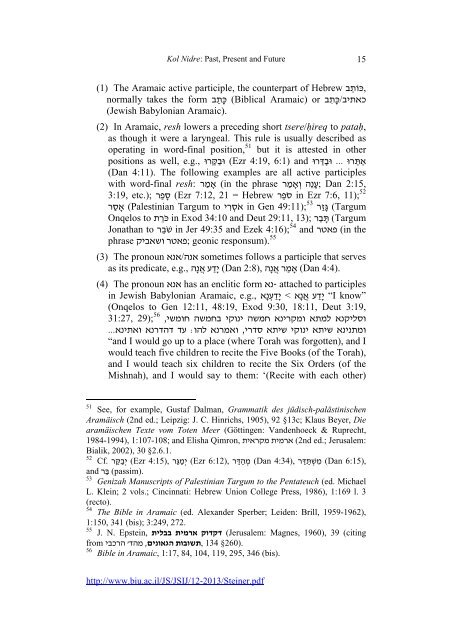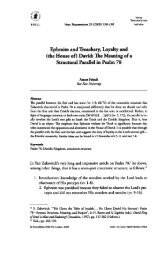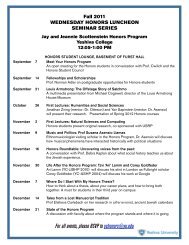Richard Steiner, Kol Nidre - Yeshiva University Blogs
Richard Steiner, Kol Nidre - Yeshiva University Blogs
Richard Steiner, Kol Nidre - Yeshiva University Blogs
You also want an ePaper? Increase the reach of your titles
YUMPU automatically turns print PDFs into web optimized ePapers that Google loves.
<strong>Kol</strong> <strong>Nidre</strong>: Past, Present and Future15,כּוֹתֵ ב (1) The Aramaic active participle, the counterpart of Hebrewכאתיב/כָּתִ ב (Biblical Aramaic) or כָּתֵ ב normally takes the form(Jewish Babylonian Aramaic).(2) In Aramaic, resh lowers a preceding short tsere/ḥireq to pataḥ,as though it were a laryngeal. This rule is usually described asoperating in word-final position, 51 but it is attested in otherאַתַּ רוּ ... and (Ezr 4:19, 6:1) רוּ e.g., positions as well,(Dan 4:11). The following examples are all active participleswith word-final resh: אָמַ ר (in the phrase נֵה וְ אָמַ ר ;עָ Dan 2:15,3:19, etc.); סָ פַ ר (Ezr 7:12, 21 = Hebrew סֹפֵ ר in Ezr 7:6, 11); 52(Targum גָּזַ ר 49:11); 53 in Gen אֹסְ רִ י (Palestinian Targum to אָסַ רOnqelos to כֹּרֵ ת in Exod 34:10 and Deut 29:11, 13); תָּ בַ ר (TargumJonathan to שֹׁבֵ ר in Jer 49:35 and Ezek 4:16); 54 and פאטר (in thephrase ושאביק ;פאטר geonic responsum). 55וּבִַ דַּ רוּוּ בַ ַקּ(3) The pronoun אנה/אנא sometimes follows a participle that servesas its predicate, e.g., יָדַ ע אֲ נָה (Dan ,(2:8 אָמַ ר אֲ נָה (Dan .(4:4(4) The pronoun אנא has an enclitic form נא - attached to participlesin Jewish Babylonian Aramaic, e.g., יָדַ ע אֲ נָא < יָדַ עְ נָא “I know”(Onqelos to Gen 12:11, 48:19, Exod 9:30, 18:11, Deut 3:19,,וסליקנא למתא ומקרינא חמשה ינוקי בחמשה חומשי ;(29 56 ,31:27ומתנינא שיתא ינוקי שיתא סדרי, ואמרנא להו: עד דהדרנא ואתינא...“and I would go up to a place (where Torah was forgotten), and Iwould teach five children to recite the Five Books (of the Torah),and I would teach six children to recite the Six Orders (of theMishnah), and I would say to them: ‘(Recite with each other)51See, for example, Gustaf Dalman, Grammatik des jüdisch-palästinischenAramäisch (2nd ed.; Leipzig: J. C. Hinrichs, 1905), 92 §13c; Klaus Beyer, Diearamäischen Texte vom Toten Meer (Göttingen: Vandenhoeck & Ruprecht,1984-1994), 1:107-108; and Elisha Qimron, ארמית מקראית (2nd ed.; Jerusalem:Bialik, 2002), 30 §2.6.1.52Cf. יְ בַ קַּ ר (Ezr ,(4:15 יְ מַ גַּר (Ezr ,(6:12 מְ הַ דַּ ר (Dan ,(4:34 מִ שְׁ תַּ דַּ ר (Dan ,(6:15and בַּ ר (passim).53Genizah Manuscripts of Palestinian Targum to the Pentateuch (ed. MichaelL. Klein; 2 vols.; Cincinnati: Hebrew Union College Press, 1986), 1:169 l. 3(recto).54The Bible in Aramaic (ed. Alexander Sperber; Leiden: Brill, 1959-1962),1:150, 341 (bis); 3:249, 272.55J. N. Epstein, דקדוק ארמית בבלית (Jerusalem: Magnes, 1960), 39 (citing, מהד' הרכבי from, 134 §260).56Bible in Aramaic, 1:17, 84, 104, 119, 295, 346 (bis).תשובות הגאוניםhttp://www.biu.ac.il/JS/JSIJ/12-2013/<strong>Steiner</strong>.pdf







